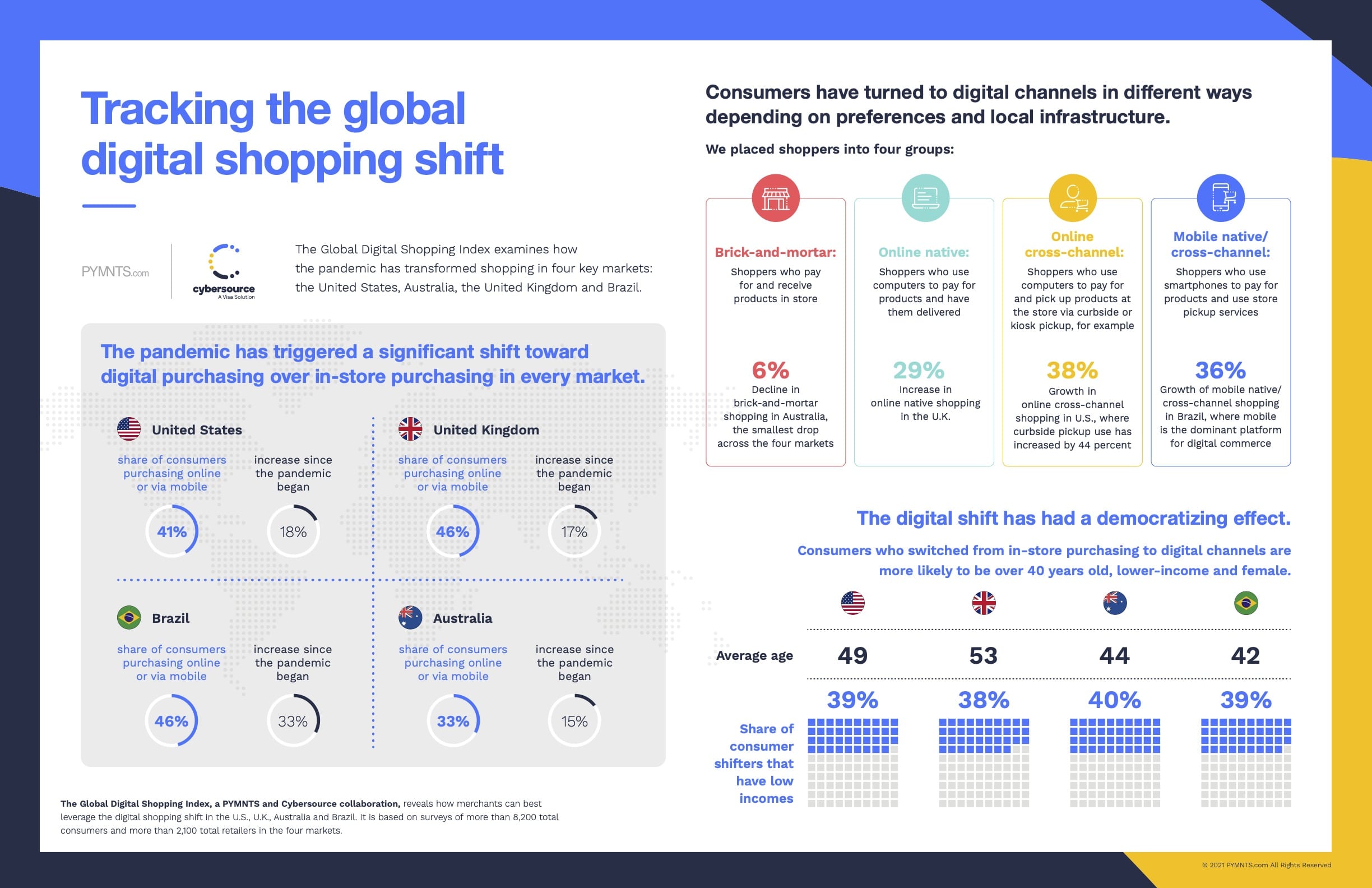A Whole New World: PYMNTS Tracks The Digital Shift At A Global Scale

The phrase “a whole new world” or “a different world” gets thrown around a lot — usually fairly casually and hyperbolically. But every once and again the phrase “a whole new world” lives up to its billing, and the year 2020 was inarguably one of those times. In every market PYMNTS surveyed as part of our Global Shopping Index work, consumers in the U.S., Australia, the U.K. and Brazil are all shopping more digitally than they were pre-pandemic. As seen in the infographic below, digital access is becoming increasingly democratized and accessible to a wider number and variety of consumers.

Of course, differences persist. Local infrastructure and preferences have a determinative role to play when it comes to defining digital channels in different markets. The presentation may vary, but at root it’s all a connected digital shift that is looking increasingly more like a permanent relocation than a temporary change. It’s a different world out there — and from PYMNTS data, it looks like it might just stay that way.
The Democratizing Effect Of The Digital Shift
Pre-pandemic, our mental image of the digital customer was probably a young, affluent, male tech enthusiast and early adopter who likes to live on the bleeding edge of new innovation. Whether or not that was ever an accurate mental image is a matter for debate; not debatable is how entirely inaccurate it is in the wake of the post-pandemic digital shift. Being digital is no longer an exclusive club keeping customers out, but has shifted into an easier on ramp for bringing them in. Consumers who switched from in-store purchasing to digital channels, according to PYMNTS data worldwide, are more likely to be over 40 years old, lower-income and female.
In the U.K. the nine percent of consumers who made the most dramatic digital shift since the pandemic’s onset — from preferring wholly in-store shopping to wholly digital channels — are older than average and disproportionately come from lower- and middle-income brackets. Their average age is 53, and 61 percent are female. In the U.S. the data is similar, though the average ages remain a bit lower and the sample set is more female. Of the 8.9 percent of consumers who have shifted their shopping journeys from in-store to digital since, the set is disproportionately from lower income groups, are older than average and are more likely to be female. Some 36.7 percent make less than $50,000 a year, their average age is 48.9 and 67.1 percent are female.
The pattern extends to Australia as well, to an extent. Of the 6.3 percent of Australian consumers who were big digital shifters, the average age was 43.6 and 64.3 percent were female. What set Australia apart was that low income was less of a growth area as digital shifters showed up from all income brackets down under.
Brazil was also slightly divergent from the general pattern, as digital shopping earned nearly equal interest for both low income and affluent consumers. Thirty-nine percent of digital shifters are low-income, 35 percent are high-income and their average age is 42. As was the case worldwide, women made up the majority of shifting, with 68 percent being female.
The Move In Every Market
The shift has been everywhere to varying degrees. Brazil has shown the most dramatic shift, with 33 percent of consumers reporting shopping more online than physically since the pandemic began. Mobile technologies have been a key enabler of these shifts, as Brazilian consumers are twice as likely to make purchases using mobile channels rather than computers. More than twice the share of consumers (20 percent) reported using mobile devices to make their most recent purchases as opposed to using a computer. The share using mobile-native and cross-channel has also shot up 36 percent — an outlier in Brazil, as consumers in the U.S., U.K. and Australia have all seen their mobile usage rates decline over the course of the pandemic.
For U.S. consumers, for example, the use of multiple channels to shop and pay has decreased significantly since March, moving from 13 percent then to 4 percent in July. The shift was most pronounced regarding the use of online versus mobile channels. The share using computers to find and purchase retail products online rose by more than four times, reaching 39.1 percent in July. In the U.K. close to half of all U.K. consumers — 46 percent — now prefer to start their shopping trips digitally, and 63 percent of those within this group want their purchases delivered to their homes. Additionally, the share of brick-and-mortar shoppers has declined by 11 percent to the point that in-store shopping is preferred by just 54 percent of U.K. consumers.
Australia has seen the least drastic digital shit by the numbers, with 33 percent of consumer shopping online or on mobile and 15 percent reporting an increase since the pandemic started. In-store shopping also remains prevalent, with 67 percent of consumers continuing to express a preference for it even after the pandemic started.
Local Differences
For all the similarities in behavior the pandemic has surfaced, PYMNTS data also shows differences in patterns emerging depending on the specifics of the location. Australia’s preference for physical shopping and the relatively minimal decline in its use (6 percent) is echoed in the digitally-enabled channels preferred. While buy online, pick up curbside is preferred in the U.S., U.K. and Brazil, for example, buy online, pick up in store remains the more popular omnichannel variation in Australia. This may also reflect the reality that curbside pickup is a less-developed practice in Australia, while in-store pickup or “click and collect” has been gaining traction for some time.
The U.S., on the other hand, has seen the biggest pickup in online cross-channel shopping, which has increased by 38 percent, while buy online, pick up curbside is up 44 percent nationwide. U.K consumers have made the most distinct defection to digital, with 29 percent now identifying as digital natives who prefer to buy online and skip the store entirely and have it delivered, while 36 percent of Brazilian consumers have become mobile native cross-channel shoppers, as is consistent with their stronger-than-average mobile uptick.
The difference in forms is a nod to the societies that pre-existed the pandemic — and to what level of technological infrastructure consumers have had at their demand since the pandemic started.
But beyond those specifics, the data demonstrated, consumers are finding ways to make those digital shifts happen everywhere and anywhere they can, flavored with the spice of local preferences.
